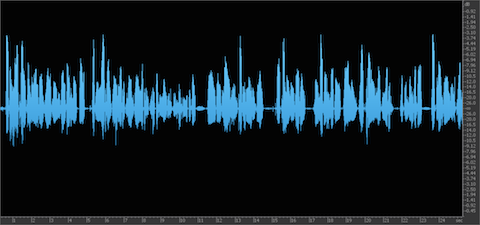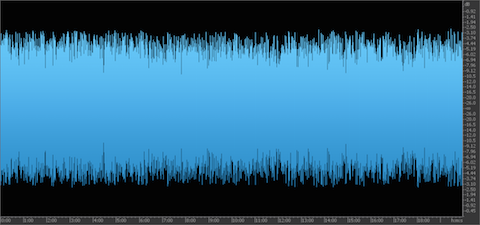Asymmetric Waveforms: Should You Be Concerned?
In order to understand the attributes of asymmetric waveforms, it’s important to clarify the differences between DC Offset and Asymmetry …
Waveform Basics
A waveform consists of both a Positive and Negative side, separated by a center (X) axis or “Baseline.” This Baseline represents Zero (∞) amplitude as displayed on the (Y) axis. The center portion of the waveform that is anchored to the Baseline may be referred to as the mean amplitude.
DC Offset
DC Offset occurs when the mean amplitude of a waveform is off the center axis due to differing amounts of the signal shifting to the positive or negative side of the waveform.
One common cause of this shift is when faulty electronics insert a DC current into the signal. This abnormality can be corrected in most file based editing applications and DAW’s. Left uncorrected, audio with DC Offset will exhibit compromised dynamic range and a loss of headroom.
Notice the displacement of the mean amplitude:
The same clip after applying DC Offset correction. Also, notice the preexisting placement of (+/-) energy:
Asymmetry
Unlike waveforms that indicate DC Offset, Asymmetric waveform’s meanamplitude will reside on the center axis. However the representations of positive and negative amplitude (energy) will be disproportionate. This can inhibit the amount of gain that can be safely applied to the audio.
In fact, the elevated side of a waveform will tap the target ceiling before it’s counterpart resulting in possible distortion and the loss of headroom.
High-pass filters, and aggressive low-end processing are common causes of asymmetric waveforms. Adding gain to asymmetric waveforms will further intensify the disproportionate placement of energy.
In this example I applied a high-pass filter resulting in asymmetry:
Broadcast Chains
Broadcast engineers closely monitor positive to negative energy distribution as their audio passes through various stages of transmission. Proper symmetry aides in the ability to process a signal more effectively downstream. In essence uniform gain improves clarity and maximizes loudness.
Podcasts
In spoken word – symmetry allows the voice to ride higher in the mix with a lower risk of distortion. Since many Podcast Producers will be adding gain to their mastered audio when loudness normalizing to targets, the benefits of symmetric waveforms are obvious.
In the event an asymmetric waveform represents audio with audible distortion and/or a loss of headroom, a Phase Rotator can be used to reestablish proper symmetry.
Below is a segment lifted from a distributed Podcast (full zoom out). Notice the lack of symmetry, with the positive side of the waveform limited much more aggressively than the negative:
The same clip after Phase Rotation:
(I processed the clip above using the Adaptive Phase Rotation option located iniZotope’s RX 4 Advanced Channel Ops module.)
In Conclusion
Please note that asymmetric waveforms are not necessarily bad. In fact the human voice (most notably male) is often asymmetric by nature. If your audio is well recorded, properly processed, and pleasing to the ear … there’s really no need to attempt to correct any indication of asymmetry.
However if you are noticing abnormal displacement of energy, it may be worth looking into. My suggestion would be to evaluate your workflow and determine possible causes. Listen carefully for any indication of distortion. Often a slight EQ tweak or a console setting modification is all that may be necessary to make noticeable (audible) improvements to your audio.
-paul.
Julian Ludwig é diretor do Pro Áudio Clube, produtora de áudio Jacarandá, Loc On Demand e Jacarandá Licensing. Trabalhou para empresas como: Guaraná Antartica, TV Gazeta, NET, Chivas Regal, FNAC, Prefeitura de São Paulo, Mukeca Filmes, Agência LEW’LARA TBWA, Agencia MPM, Agência Content House entre outras. Fez trilhas para programas de TV como: Internet-se (Rede TV), Você Bonita (TV Gazeta), Mix Mulher (TV Gazeta), Os Impedidos (TV Gazeta), Estação Pet (TV Gazeta), CQC (TV Band) Vinheta Oficial TV Gazeta, entre outras. Também atuou em vários longas e curtas metragens, incluindo mixagem em 5.1 e serviços de pós-produção.







